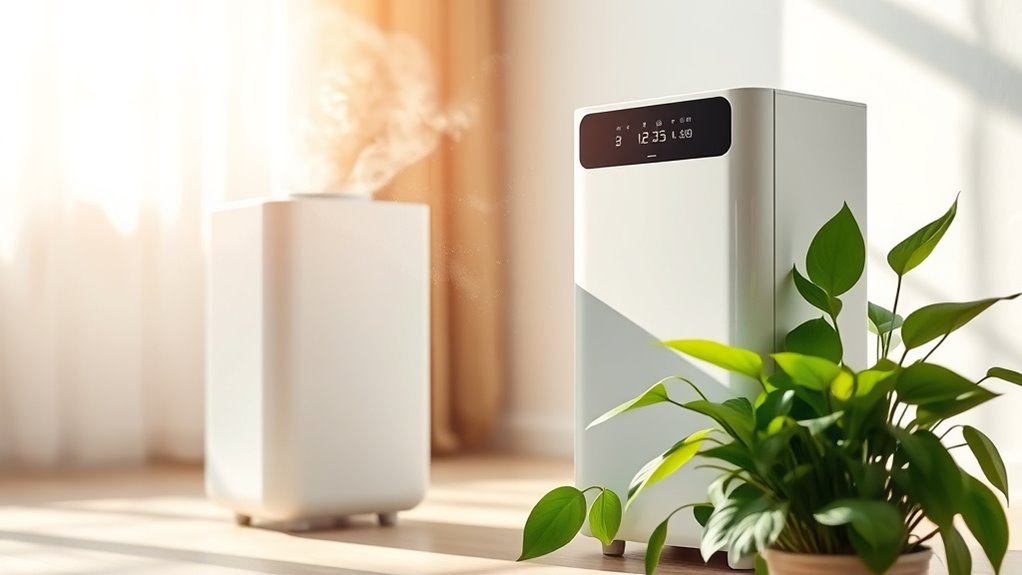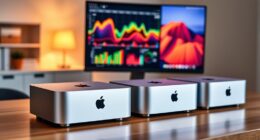Air purifiers improve air quality by using fans to pull in contaminated air and pass it through filters, like HEPA, which capture 99.5% of allergens and harmful particles. They can tackle dust, pollen, smoke, and even some gases with the right additional filters. Regular maintenance is essential to keep them functioning well. Discover how different types of purifiers work and which one suits your needs best for ideal air quality.
Key Takeaways
- Air purifiers draw in contaminated air using fans and filter it through HEPA or activated carbon filters to capture pollutants.
- HEPA filters remove at least 99.5% of particles like dust, pollen, and pet dander, improving air quality significantly.
- Continuous use of air purifiers can lower particulate matter concentrations and maintain optimal indoor air quality.
- Activated carbon filters are essential for adsorbing harmful gases and volatile organic compounds, enhancing overall air purification.
- Regular maintenance and filter replacement ensure air purifiers operate efficiently, maximizing their effectiveness in improving air quality.
Understanding Air Purifiers
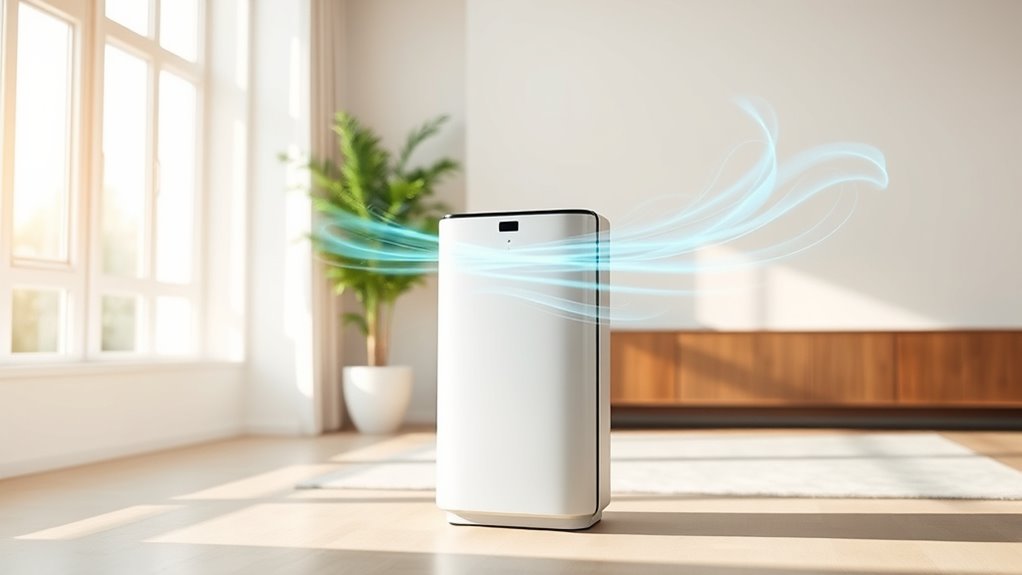
When you want to breathe cleaner air, understanding how air purifiers function is vital. Air purifiers use fans to draw in contaminated air, passing it through HEPA filters that capture at least 99.5% of particles and pollutants as small as 3 microns. This process greatly improves indoor air quality by trapping harmful particles and re-circulating cleaner air back into your space. Portable air purifiers are ideal for single rooms, while whole-house systems connect to your HVAC for broader coverage. Regular cleaning is essential for optimal performance of air purifiers, ensuring they continuously operate at peak efficiency. Many modern air purifiers also utilize UV light technology to kill bacteria and viruses, further enhancing the air quality in your environment. Air purifiers like the Germ Guardian and Honeywell models are particularly effective due to their advanced filtration systems, which target a wide range of pollutants.
The air delivery rate and clean air delivery rate are important metrics that determine how effectively an air purifier cleans your air. Many models incorporate multiple filters to tackle various contaminants, enhancing their air purification capabilities for a healthier environment. Regular use of air purifiers can lead to improved respiratory health, alleviating symptoms of asthma and allergies, and they often feature advanced technologies that contribute to their effectiveness.
How Air Purifiers Work
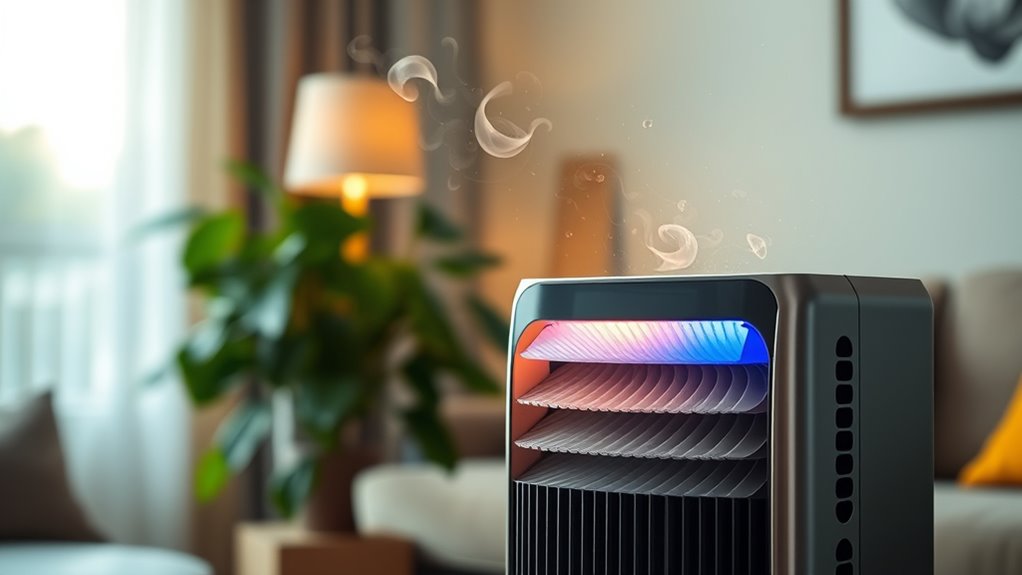
Air purifiers function by drawing in indoor air with a fan, filtering out pollutants, and releasing cleaner air back into your space.
Most portable air purifiers use HEPA filters, capturing at least 99.5% of airborne pollutants like dust, pollen, and pet dander. Regular maintenance, including cleaning filters regularly, helps ensure the effectiveness of the purification process. Additionally, smart features can enhance user experience by providing real-time monitoring of air quality. The efficiency of air purifiers can vary significantly, much like the energy-efficient models found in heat pumps. The Clean Air Delivery Rate (CADR) measures how quickly and efficiently your purifier filters air, helping you understand its effectiveness. Furthermore, air purifiers that use heat pumps can enhance energy efficiency, making them a sustainable choice for improving indoor air quality.
Most portable air purifiers utilize HEPA filters, effectively trapping over 99.5% of airborne allergens like dust and pollen.
Some models include activated carbon filters to filter gases and remove volatile organic compounds (VOCs) and odors.
Regular maintenance, such as timely filter replacements, is essential for maintaining ideal indoor air quality and ensuring your air purifier effectively reduces allergens and other irritants, which can alleviate respiratory conditions and improve overall health. Additionally, some air purifiers utilize UV-C light technology to kill bacteria and viruses, enhancing the overall purification process.
Types of Air Purifiers

Whether you’re looking to tackle allergens in a specific room or improve air quality throughout your entire home, understanding the different types of air purifiers can help you make an informed choice.
Portable air purifiers focus on individual spaces, while whole-house systems integrate with HVAC for broader coverage. Most utilize HEPA filters, effectively capturing at least 99.5% of allergens and indoor pollutants. Well-draining soil is also crucial for maintaining healthy indoor plants, which can further enhance air quality. Some air purifiers may also benefit from proper sealing mechanisms to improve their overall efficiency in trapping pollutants. Additionally, creating a calm environment through decluttering can complement the air purification process by reducing airborne dust and allergens. Cold-pressed vegetable juices, rich in antioxidants, can also contribute to a healthier living space by promoting overall wellness.
Many also include activated carbon filters to adsorb gaseous pollutants like VOCs and odors. Some models feature ionizers, but they can produce ozone, which is harmful.
When evaluating air purifiers, pay attention to the Clean Air Delivery Rate (CADR), ensuring it matches the room size for ideal air quality improvement. Additionally, just as Tesla vehicles rely on electricity for operation, air purifiers need a consistent power source to function effectively and provide clean air.
Effectiveness Against Allergens
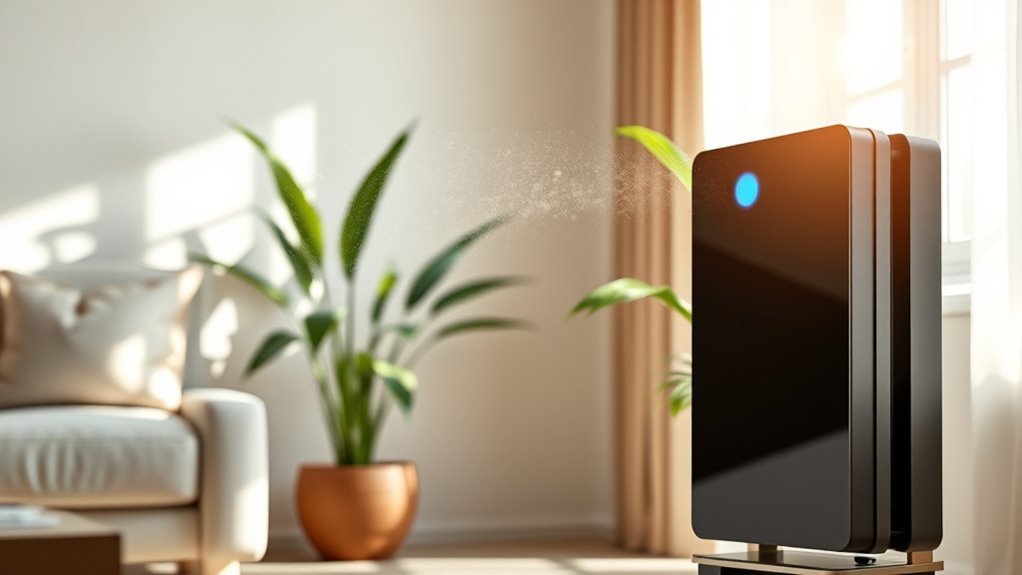
While you might think that simply having an air purifier will solve your allergy issues, it’s vital to understand how effective these devices are against airborne allergens.
Air purifiers with HEPA filters can capture at least 99.5% of particles like dust mites, pollen, and pet dander, improving indoor air quality. They can also lower indoor particulate matter (PM2.5) concentrations by up to 50%, which is beneficial for those with allergies. Additionally, the effectiveness of air purifiers can be enhanced by ensuring proper room size for optimal air circulation and filtration efficiency. Using an air purifier continuously can help maintain optimal air quality throughout your home. Regular filter cleaning is also essential for maintaining the performance of your air purifier. Furthermore, incorporating essential oils for relaxation can create a soothing atmosphere that complements the air purification process.
To maximize effectiveness, guarantee the air delivery rate (CADR) is appropriate for your room size and use the purifier continuously. Furthermore, combining air purifiers with natural remedies may help provide additional relief for allergy sufferers.
Addressing Mold and Smoke
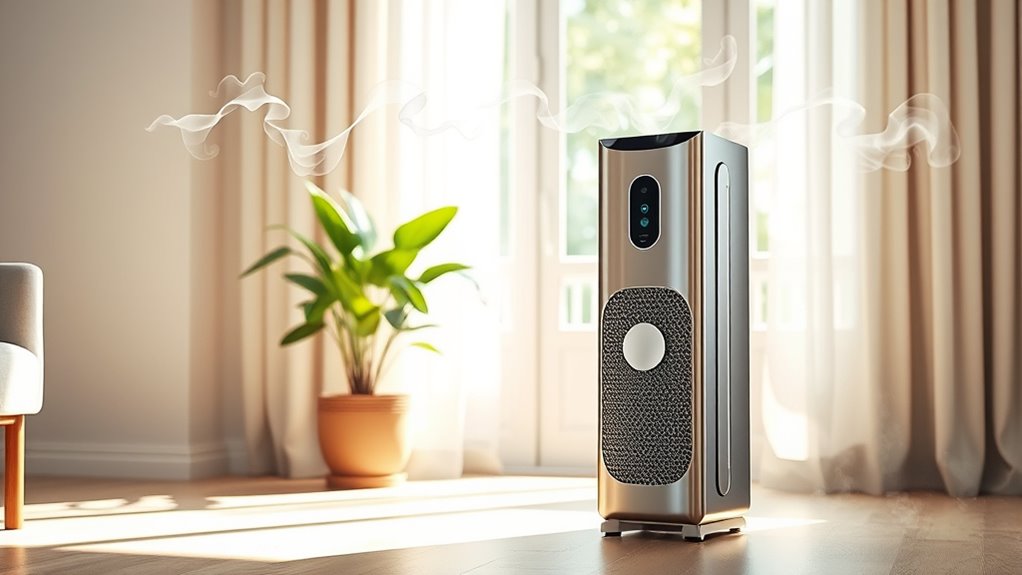
Mold and smoke in your indoor environment can pose significant health risks, and addressing them requires more than just relying on an air purifier.
While air purifiers equipped with HEPA filters can capture at least 99.5% of mold spores and particulate matter from smoke, they don’t eliminate the root causes. You still need to tackle moisture sources to control mold effectively. Additionally, implementing home improvement strategies can further enhance the overall indoor air quality. For instance, regular maintenance of ventilation systems can prevent the buildup of contaminants that contribute to poor air quality. Moreover, using heat pumps with advanced filtration systems can help improve both air circulation and quality.
Additionally, air purifiers aren’t very effective against gaseous components like nicotine and volatile organic compounds found in smoke. To improve air quality, combine air purifiers with better ventilation and humidity control. Maintaining a cleaner home helps you reduce contamination and maintain a healthier indoor environment.
Filtering Gaseous Pollutants
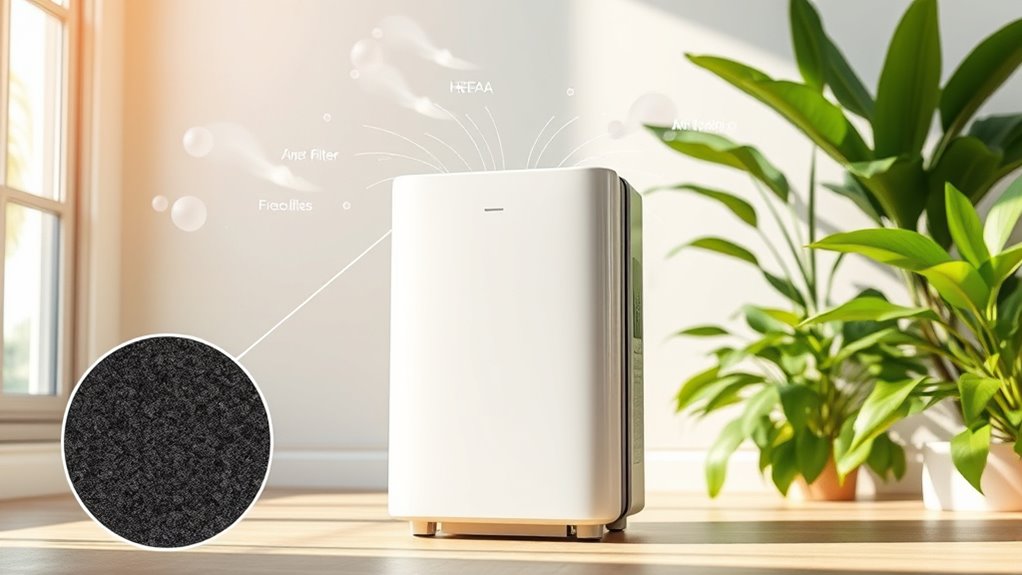
When it comes to filtering gaseous pollutants, you’ll find that activated carbon filters are your best bet.
These filters effectively adsorb harmful gases like VOCs and carbon monoxide, helping improve your indoor air quality.
However, it’s important to remember that not all air purifiers can tackle these pollutants equally, so knowing their limitations is key.
Types of Gaseous Pollutants
Indoor air can often be tainted by various gaseous pollutants that threaten your health, such as carbon monoxide, nitrogen dioxide, ozone, and volatile organic compounds (VOCs).
These pollutants can considerably degrade your air quality and pose serious health risks. While HEPA filters can capture particles, they’re ineffective against these gaseous pollutants, making activated carbon filters vital for effective removal.
Air purifiers equipped with activated carbon can adsorb gases and odors, but their effectiveness largely hinges on the quality and quantity of carbon used.
To guarantee ideal performance, regular maintenance and timely replacement of filters are critical. By understanding the types of gaseous pollutants and investing in the right air purifiers, you can better protect your indoor environment.
Activated Carbon Filters
Activated carbon filters play an essential role in improving your indoor air quality by effectively trapping harmful gaseous pollutants.
These filters use a process called adsorption, allowing gas molecules to adhere to the porous surface of activated carbon, which has a vast area for capturing contaminants.
While HEPA filters excel at removing particulate matter, they can’t handle volatile organic compounds (VOCs) or chemical fumes.
To maintain ideal air purification performance, consider these key points:
- Regular replacement is vital to prevent saturation, which reduces effectiveness.
- Activated carbon filters specifically target gaseous pollutants, enhancing your indoor air quality.
- Humidity and concentration levels can impact adsorption, making routine checks important.
Limitations of Air Purifiers
While air purifiers are effective at capturing particulate matter, they’ve notable limitations when it comes to filtering gaseous pollutants.
HEPA filters excel at trapping particles, but they can’t effectively remove gases or volatile organic compounds (VOCs). Studies show that consumer-grade air purifiers struggle to capture significant amounts of these gaseous pollutants, often leaving your air quality compromised.
Additionally, some purifiers might even release harmful VOCs back into the air, counteracting their cleaning benefits. Smoke, nicotine, and carbon monoxide aren’t adequately filtered by standard HEPA filters, which limits their effectiveness in environments with these gases.
To truly improve air quality, consider using activated carbon filters alongside your air purifier for better control over gaseous pollutants.
The Role of Plants in Air Quality
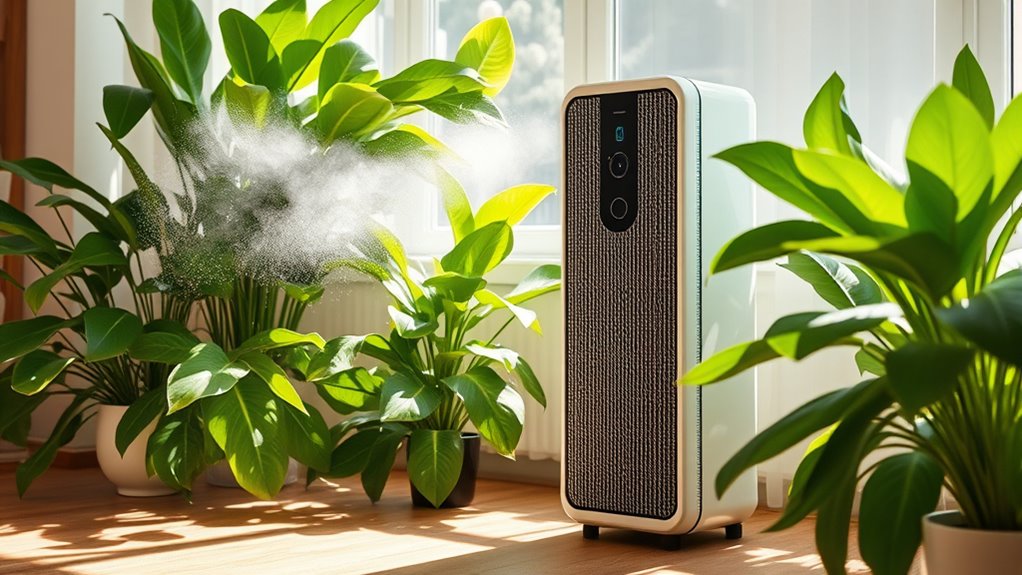
Plants act as natural air filters, improving your indoor environment by absorbing carbon dioxide and releasing oxygen.
By incorporating certain houseplants, like spider plants and peace lilies, you can reduce harmful airborne pollutants and enhance your air quality.
Plus, having greenery around can boost your mood and reduce stress, making your space feel even more inviting.
Natural Air Filtration
One of the simplest ways to improve your indoor air quality is by incorporating houseplants into your space.
Plants naturally filter the air by absorbing carbon dioxide and releasing oxygen, which can greatly enhance your indoor environment. They’re particularly effective at removing airborne particles and volatile organic compounds (VOCs) that can lead to respiratory irritations.
- Certain plants, like spider plants and peace lilies, excel at removing common indoor pollutants.
- They can increase humidity levels, alleviating dry air issues.
- Plus, they add aesthetic appeal to your home.
Benefits of Indoor Plants
You might be surprised at how much indoor plants can enhance your home’s air quality.
These green companions work hard to improve indoor air quality by absorbing carbon dioxide and releasing oxygen through photosynthesis. Certain plants, like the peace lily and spider plant, effectively remove airborne particles and volatile organic compounds (VOCs), considerably reducing air pollution.
Research shows that indoor plants can lower VOC levels by up to 60%, creating a cleaner environment. Additionally, they help decrease dust mites and airborne dust, which can alleviate allergy symptoms for sensitive individuals.
Recommended Air Purifiers
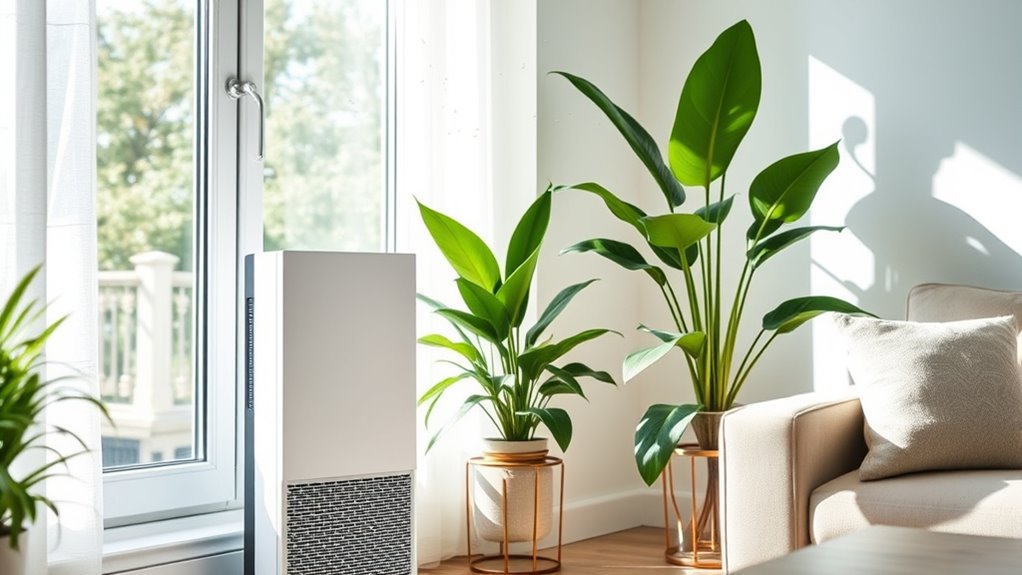
When it comes to choosing the right air purifier, several top-rated options stand out in 2025.
These models can greatly improve your indoor air quality and help manage allergens and pet dander effectively.
- LEVOIT Air Purifier Core 300S-P: Wi-Fi-enabled and perfect for medium-sized rooms at $149.99.
- Medify MA-50: Features a True HEPA H13 filter, covering up to 2,640 sq. ft. for $269.99.
- Shark HP201 & HP202: Designed for pet owners, capturing pet dander and odors seamlessly.
Finding the best air purifier depends on your space and needs.
Whether you prefer portable air cleaners or need high CADR ratings, these models are sure to enhance your air quality.
Maintenance and Usage Tips
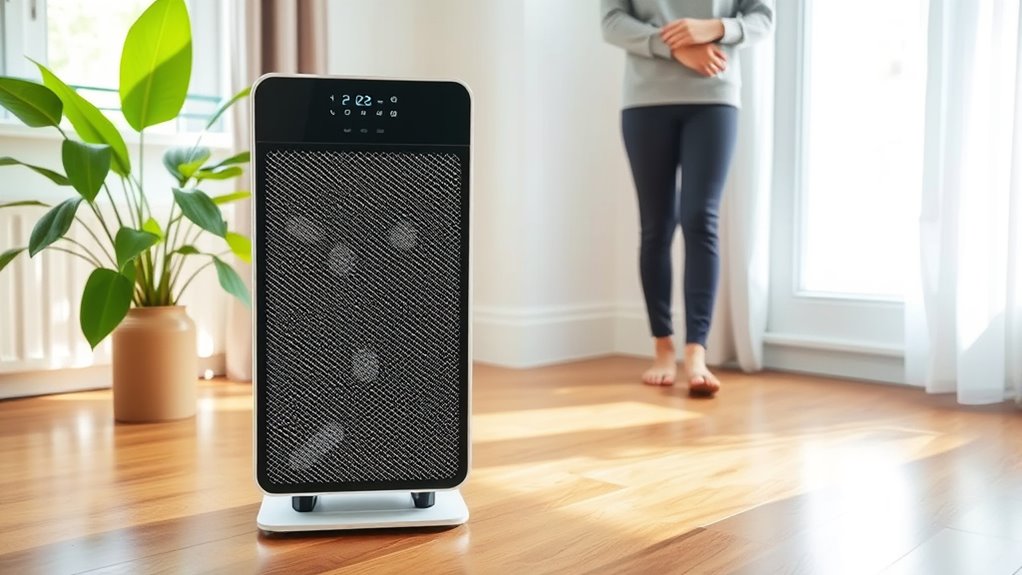
Choosing the right air purifier is just the first step in ensuring clean air at home; proper maintenance and usage play an essential role in its effectiveness.
Regularly replace or clean the filters according to the manufacturer’s guidelines to maintain efficiency, as clogged filters can greatly reduce airflow and performance.
Regular filter maintenance is crucial; clogged filters hinder airflow and diminish your air purifier’s effectiveness.
Make sure your air purifier’s Clean Air Delivery Rate (CADR) is suitable for your room size, ideally at least two-thirds of the room area.
Position it away from walls and obstructions to maximize airflow. For best results, use the air purifier continuously to effectively capture airborne pollutants.
Finally, keep the surrounding area clean to enhance the air quality and the purifier’s overall performance.
Frequently Asked Questions
Do Air Purifiers Really Improve Air Quality?
Yes, air purifiers really do improve air quality.
When you use one, it draws in contaminated air and filters out allergens like dust and pollen, releasing cleaner air back into your space.
By regularly maintaining the filters and using the purifier consistently, you can considerably reduce airborne pollutants.
Just remember, they’re less effective against certain gases unless they’ve activated carbon filters, so consider that when choosing one for your home.
Do Air Purifiers Actually Clean the Air?
Imagine coming home after a long day and breathing in fresh, clean air thanks to your air purifier.
Yes, air purifiers do actually clean the air! They draw in airborne particles like dust and pollen, trapping them in filters.
For instance, a study found that air purifiers reduced indoor allergens by 50%, making a noticeable difference for allergy sufferers.
Just remember, their effectiveness depends on factors like room size and regular filter changes.
Is There Any Science Behind Air Purifiers?
Yes, there’s solid science behind air purifiers. They use advanced filtration techniques, like HEPA filters, to capture harmful particles from the air, including dust and pollen.
Studies show they can markedly reduce airborne pollutants, improving your indoor air quality. By drawing in contaminated air and circulating cleaner air back into your space, they help create a healthier environment for you and your family.
How Does an Air Purifier Know the Air Quality?
Air purifiers know the air quality through built-in sensors that detect pollutants like PM2.5 and VOCs.
When you turn on your air purifier, these sensors measure the levels of airborne contaminants in real-time. If the air quality drops, the purifier adjusts its filtration speed automatically.
Many models even use color-coded indicators or digital displays, so you can easily see when your indoor air needs attention or is already clean.
Conclusion
In the battle for cleaner air, air purifiers are your trusty allies. By understanding how they work and their effectiveness against various pollutants, you can breathe easier in your home. Whether it’s tackling allergens, mold, or even smoke, these devices play an essential role in enhancing your indoor air quality. Remember, with the right maintenance and usage tips, you’ll keep your air fresh and your lungs happy. So, why not invest in your well-being today?
